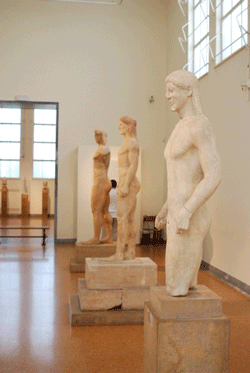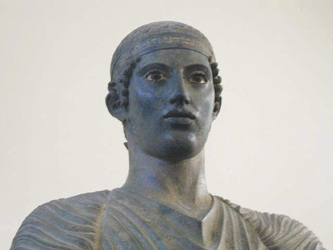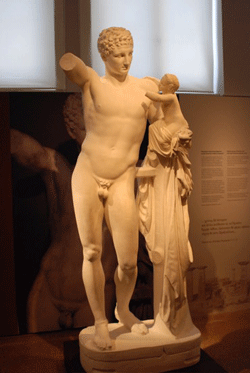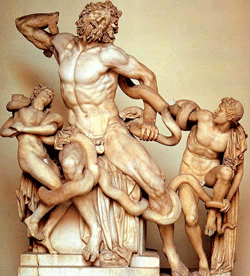Johann Joachim Winckelmann (1717-1768) could very well be called the father of Hellenic archaeology, although naturally there are problems in such a definition. The son of a cobbler, Winckelmann was extremely knowledgeable in Greek studies, particularly Homer. He studied theology at the University of Halle and medicine at the University of Jena, but his first encounter with the world of Greek art was in 1748 when he was given a job as the librarian to the Count von Bünau. In an essay he wrote as the count’s historian, he said, “The only way for us to become great, or even inimitable if possible, is to imitate the Greeks.” That essay would become one of the staples in Greek scholarship during his time.
Interestingly enough, Winckelmann never traveled to Greece. He worked almost exclusively in Rome, and all of his analyses were based on his studies of artwork that had been brought back to Europe. Winckelmann proposed a dramatic reordering of the shambles that was ancient art, which prior to his work had been based almost completely on issues of authorship and visual content, rather than close attention to a progression and growth in Greek artwork.
In Winckelmann’s consideration, there were four main (and clear-cut) periods in Greek art, which he laid down in his definitive work Geschichte der Kunst des Altertums (History of the Art of Antiquity) in 1764. The first was the ‘straight and hard’ phase, comprising mostly sculpture from the Archaic period (before Phidias). The second was the ‘grand and square’ phase, with sculptures from the early Classical period (such as Phidias and Polyclitus), while the third, from the late Classical period, was called the ‘beautiful and flowing’ stage (including works by the sculptor Praxiteles). The last stage, comprising pretty much anything made after the third stage, was considered by Winckelmann to be merely imitative and thus inferior.
Winckelmann’s impact on the archaeological attitudes of his time was profound: after his work, nearly all scholars and travelers looked at Greece through his terms—which, of course, exemplified the Hellenic ideal. Winckelmann himself came to be a venerated figure: he worked alternately as the librarian of the Vatican, president of Antiquities and the secretary to Cardinal Albani (a man with an immense personal collection of ancient art). Goethe described him in glowing praise: “Winckelmann is like Columbus, not yet having discovered the new world but inspired by a premonition of what is to come. One learns nothing new when reading his work, but one becomes a new man!”
As important as Winckelmann’s contribution to Greek art was, however, it is still valid and important to analyze (and criticize) the way in which he divided Greek artwork. It’s clear the Winckelmann’s work was invaluable to the study of ancient art, Greek in particular: he transformed the field from complete chaos into an orderly and respected progression. However, there are two problems with his method that must be taken into account to fully understand his impact on the field.
First of all, and perhaps mostly obviously, Winckelmann’s work was completely out of context. Having never visited Greece and studying art in Rome, Winckelmann clearly did not come to consider any of the pieces of art he studied in their appropriate historical contexts. To a modern reader this is probably not incredibly surprising—it is common in our time to view ancient artwork in a museum, another setting which takes the context out of art. But Winckelmann’s decision to divide Greek artwork into four periods reflects two assumptions that he made which probably would not have come to the mind of contemporary Greeks: first, that art was created solely for its own aesthetic value (which of course it wasn’t—more often than not the religious or social context of a specific piece of artwork was incredibly important) and second, that it was possible at all to divide artwork into distinct periods, whereas contemporary viewers would probably only have seen trends and not stark contrasts.
But it is perhaps the second problem with Winckelmann’s method that is even more important to take into consideration from a modern viewpoint of the study of archaeology. This problem is Winckelmann’s incredibly idealization of the Hellenic period. The third stage of Winckelmann’s timeline (the beautiful and flowing stage) represented in his mind the pinnacle of Greek achievement: everything before it was only leading up to it and everything after it was a less-valuable copy. Unfortunately, that habit of idealizing the Hellenic period was perpetuated by many who followed Winckelmann and is still to some extent a mind-set today.
Here are a few examples of Winckelmann's four stages of Greek art.
The "straight and hard" phase:

The "grand and square" phase:

The "beautiful and flowing" phase:

The "imitative" phase:

Sources:
Whitley, James. The Archaeology of Ancient Greece. Cambridge: Cambridge Univeristy Press, 2007.
"Winckelmann, Johann." Encyclopædia Britannica. 2007. Encyclopædia Britannica Online. 30 Nov. 2007. <http://www.britannica.com/eb/article-9077157>.
Posted at Dec 21/2007 09:13AM:
chris witmore: Great work Jacob. I like your choice of images to illustrate Wincklemann's four-stage evolutionary scheme save the Laocoon. Indeed, Wincklemann's interpretation was that Laocoon was exemplary of the 'noble simplicity and quiet grandeur' of Socrates' Athens around 400 BCE. The unidirectional nature of his scheme meant everything after the 4th was merely imitative. As such, Wincklemann wrongly attributed the 1st-century CE sculptural group to the much earlier period. Have a look at Ian Morris (1994, 17-18).
Morris, I. 1994: Archaeologies of Greece. In I. Morris (ed.) Classical Greece: Ancient histories and modern archaeologies. Cambridge.
Posted at Dec 22/2007 02:25AM:
Kuy Yeon Lee: Wow! you've done some amazing job=) It's surprising that a person who has never been to Greece can have such insights on Greek art, albeit being criticized at present. I think to consider art in its own context is very important. After I had visited Egypt few years ago, I could never view the statues or other relics that are displayed in the museum in the same way as I did before. I can imagine how Whinckelmann inevitably committed a major error here. By the way, great choices of sculptures too! They really show the key fetures well.
